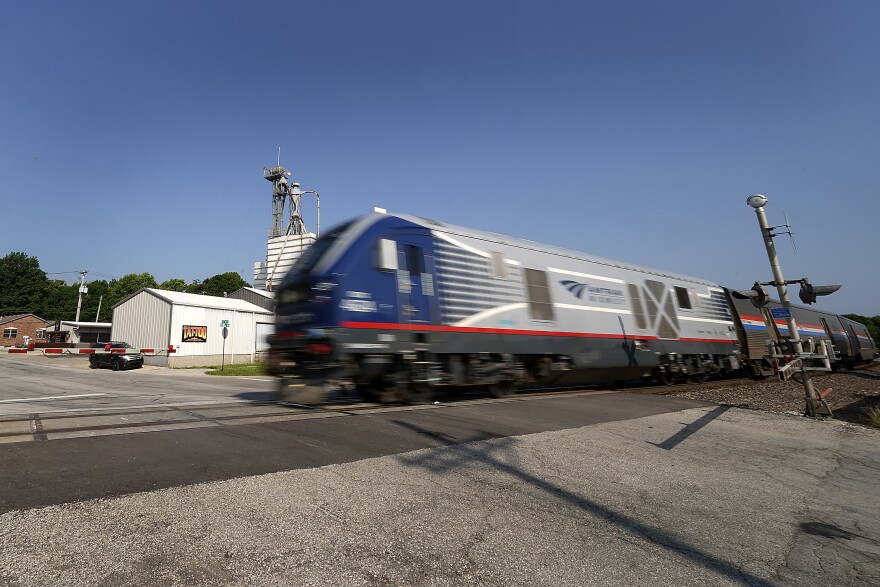BETHLEHEM, Pa. — The long-awaited passenger feasibility rail study for the Lehigh Valley, years in the making, was released Wednesday morning.
Five main corridors were identified for bringing passenger rail back to the Lehigh Valley, with connections proposed to NJ Transit, SEPTA and future planned Amtrak expansions.
All five proposed "most likely" routes would use Norfolk Southern railway lines, which presenters said could cause some difficulties because of having to contend with freight rail traffic.
The five proposals would provide connections to New York City, Philadelphia or Reading.
They include:
- Allentown to New York City via Hackettstown, New Jersey
- Allentown to New York City via High Bridge, New Jersey
- Allentown to Philadelphia via Lansdale
- Allentown to Philadelphia via Norristown
- Allentown to Reading

Delving into costs, further steps
The study was developed by WSP consultants, and is available on the Lehigh Valley Planning Commission website and will be on PennDOT's advancingparail.com site, according to speakers at the study's reveal.
The study and presentation by the Lehigh Valley Transportation Study and WSP delves into the costs and some further steps needed to bring a project to fruition, with a general project lifecycle of 10-12 years.
Next steps include identifying a project sponsor, further feasibility and alternatives study, assessment by partner railroads, and advanced conceptual engineering of a project.
It provides what officials called a "high-level view" at restoring rail passenger service to the region, and analyzed 12 former rail corridors' potential, looking at land use, environmental considerations, current rail operations, engineering constraints and costs along those pathways.
The study does not engage with specific questions of engineering, and there has not yet been communication between the Lehigh Valley Transportation Study and potential partners such as NJTransit, SEPTA or Norfolk Southern.
It does, however, delve into estimated cost, which can be seen here:

Time estimations are for total travel duration to the proposed city center destination.
Potential challenges for all routes include interference with freight transit and the existence of historic properties located on or near routes.
Public voices support, some worry
Some members of the public attending the meeting virtually critiqued the lack of high-speed rail inclusion, worried that it would not be a viable competitor to bus and car transport for many potential commuters and tourists.
"I am concerned that two and a half hours of travel time does not work for passengers," Jeff Barber, a commenter in the virtual meeting, said.
"The rail needs to be a high-speed line that saves time and money. We need to look at what is being done in Europe and Asian countries, they are lightyears ahead of the USA."
Others, such as the Lehigh Valley Coalition for Appropriate Transportation executive director Scott Slingerland, praised the progress and potential for greater interconnectivity and environmental sustainability, and pushed for station locations in the region's downtowns and for easy bus access.
"The report indicates that new construction would likely be required for the stations, but again hoping for sensible locations that coordinate with downtown's and lead to public transit to improve overall sustainability," Slingerland said.
Elected officials weigh in
Some elected officials also sounded off, echoing support for greater rail transit's potential to interconnect Southeastern PA, supporting tourism, commuters and economic value.
"As the third-largest metro region in the state, we deserve quality public transit and connectivity like what SEPTA provides to rest of the Southeast," state Rep. Josh Siegel, D-22nd District, said.
"Passenger rail connecting us to the rest of the Commonwealth will only serve to expand our endless potential for economic progress while helping encourage more dense and walkable communities, environmental sustainability and reducing the number of cars on our congested highways.
"The evidence is clear: for every dollar invested in public transit, we get five dollars back."
Allentown Mayor Matt Tuerk praised the collaboration that took place between the state Transportation Department and the LVTS in producing the study.
But Tuerk also took to social media to say, "A question is: how much public value would a train create?"
Officials noted a full ridership demand analysis has yet to be completed.
No 'insurmountable' concerns
Northampton County Executive Lamont McClure asked if there were any concerns found that would be "insurmountable."
WSP Project Manager Liz Hynes responded that, broadly, each corridor has difficulties and advantages, but that none have challenges that are insurmountable.
"Those of us who are supportive of bringing passenger rail connection to the New York metropolitan area are very grateful that this study is now done," McClure said.
"We can begin the process of moving forward, keeping this train rolling forward."
Fourteen years ago, Pennsylvania released an intercity passenger and freight rail plan with a long-term vision.
However, the report states that despite an extensive existing rail network in the region, the tracks have remained dedicated solely to freight since passenger rail service was first discontinued in the Lehigh Valley in 1979.
See the full study here:
Written public comment for the report is available on the Lehigh Valley Planning Commission website.
Connect to existing track, raise logistical concerns
Here is a look at the five main corridors the study identifies for bringing passenger rail back to the Lehigh Valley.
Allentown to New York City via Hackettstown, New Jersey:
This route would use Norfolk Southern Railway to Phillipsburg and Dover and Delaware River Railroad to connect with NJTransit's Morris & Essex Line in Hackettstown.
According to the study, it relies entirely on active rail corridors, with passenger upgrades needed.
By using Dover and Delaware River Railroad tracks, it "minimizes need to operate over Norfolk Southern" and could offer an alternative partner amenable to passenger servicer upgrades.
Concerns noted include the potential impact to Norfolk Southern freight supply chains, and that riders would have to use NJTransit and Amtrak lines east of Hackettstown.
Estimated trip duration to New York City would be 2 hours and 30 minutes, with an estimated capital cost of $474.9 million, and a rolling stock cost of $145 million.
Estimated operating costs would be $23.6 million to $28.8 million per year.
Allentown to New York City via High Bridge, New Jersey
This route would use Norfolk Southern Railway to connect with NJTransit's Raritan Valley Line in High Bridge.
It is the most direct route to New York City, but has similar concerns to the Hackettstown route of requiring the use of NJTransit and Amtrack lines east of High Bridge and also uses existing freight lines.
Estimated trip duration to New York City would be 2 hours and 20 minutes, with an estimated capital cost of $469.9 million, and a rolling stock cost of $145 million.
Estimated operating costs would be $16.5 million to $20.1 million per year.
Allentown to Philadelphia via Lansdale
This route would use Norfolk Southern Railway to Bethlehem, and Lehigh Valley Rail Management tracks within Bethlehem before switching to what would be SEPTA tracks along the Saucon Rail Trail to Coopersburg, Upper Bucks Rail Trail to Quakertown, East Penn Railroad to Telford and the Pennsylvania Northeastern Railroad to connect to the SEPTA Lansdale Doylestown Line at Lansdale station.
It would be the most direct route to Philadelphia and primarily uses in-service rail corridors, but faces the challenge of nearly 12 miles of the proposed route having been converted to public rail trails.
Optimal routing through Bethlehem is unclear, and like the New York City routes may conflict with freight rail operations.
The study also notes the challenge of contending with dense commuter rail operations already present for SEPTA services at the Lansdale location.
The study also states that dual mode diesel/electric locomotives, what currently is proposed to match existing infrastructure, may not be permitted through the Center City Philadelphia tunnel.
Estimated trip duration to Philadelphia would be 1 hour and 46 minutes, with an estimated capital cost of $635.8 million, and a rolling stock (railway vehicle) cost of $102 million.
Estimated operating costs would be $5.1 million to $10.2 million per year.
Allentown to Philadelphia via Norristown
This route would use the same pathway as the Lansdale proposal, but would connect with SEPTA Norristown Line in Norristown via CSX/Norfolk Southern rail .
The same challenges related to fuel, freight, rail trails and commuter density as the Lansdale route are noted. A diesel-only route to Philadelphia's 30th Street Station could be provided.
Estimated trip duration to Philadelphia would be 1 hour and 52 minutes, with an estimated capital cost of $739 million, and a rolling stock cost of $102 million.
Estimated operating costs would be $5.5 million to $10.8 million per year.
Allentown to Reading
This route, the shortest and least expensive of those presented, would use Norfolk Southern Railway to connect with the planned Schuylkill River Passenger Rail Authority service between Reading and Philadelphia.
Rail infrastructure is largely in place, but would require passenger service upgrades, could see more limited demand, impact freight rail and could see limitations if other proposed rail expansions are not followed through.
Estimated trip duration to Reading would be 46 minutes, with an estimated capital cost of $450.3 million, and a rolling stock cost of $102 million.
Estimated operating costs would be $2.2 million to $4.3 million per year.


